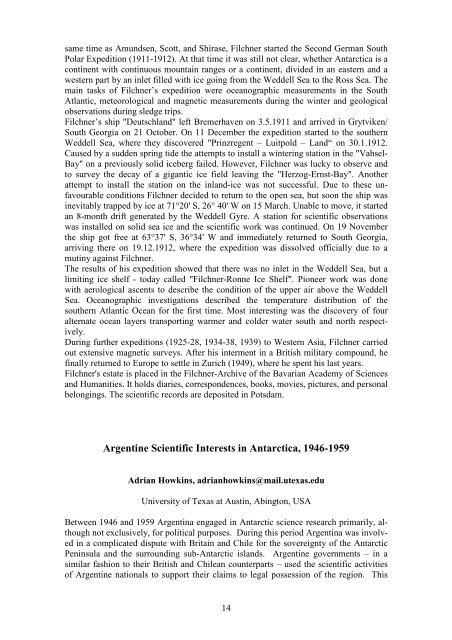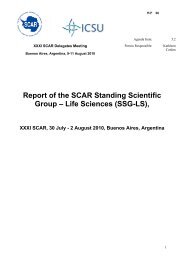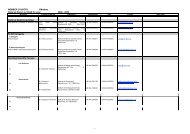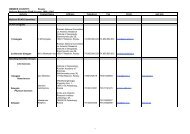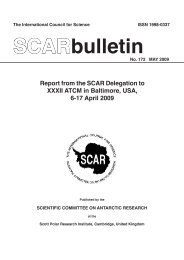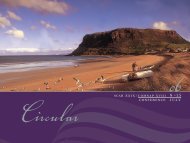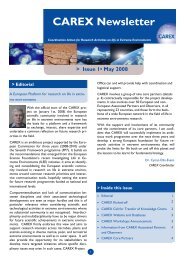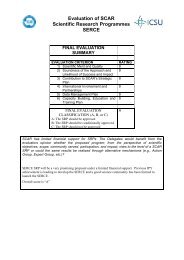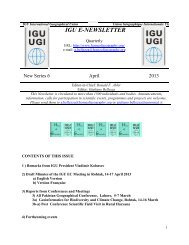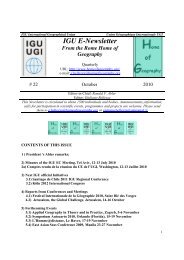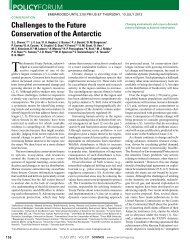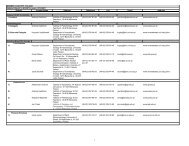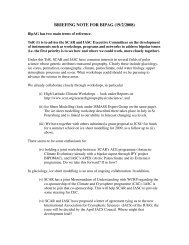SCAR Action Group History of Antarctic Research 1
SCAR Action Group History of Antarctic Research 1
SCAR Action Group History of Antarctic Research 1
Create successful ePaper yourself
Turn your PDF publications into a flip-book with our unique Google optimized e-Paper software.
same time as Amundsen, Scott, and Shirase, Filchner started the Second German South<br />
Polar Expedition (1911-1912). At that time it was still not clear, whether <strong>Antarctic</strong>a is a<br />
continent with continuous mountain ranges or a continent, divided in an eastern and a<br />
western part by an inlet filled with ice going from the Weddell Sea to the Ross Sea. The<br />
main tasks <strong>of</strong> Filchner’s expedition were oceanographic measurements in the South<br />
Atlantic, meteorological and magnetic measurements during the winter and geological<br />
observations during sledge trips.<br />
Filchner’s ship "Deutschland" left Bremerhaven on 3.5.1911 and arrived in Grytviken/<br />
South Georgia on 21 October. On 11 December the expedition started to the southern<br />
Weddell Sea, where they discovered "Prinzregent – Luitpold – Land“ on 30.1.1912.<br />
Caused by a sudden spring tide the attempts to install a wintering station in the "Vahsel-<br />
Bay" on a previously solid iceberg failed. However, Filchner was lucky to observe and<br />
to survey the decay <strong>of</strong> a gigantic ice field leaving the "Herzog-Ernst-Bay". Another<br />
attempt to install the station on the inland-ice was not successful. Due to these unfavourable<br />
conditions Filchner decided to return to the open sea, but soon the ship was<br />
inevitably trapped by ice at 71°20' S, 26° 40' W on 15 March. Unable to move, it started<br />
an 8-month drift generated by the Weddell Gyre. A station for scientific observations<br />
was installed on solid sea ice and the scientific work was continued. On 19 November<br />
the ship got free at 63°37' S, 36°34' W and immediately returned to South Georgia,<br />
arriving there on 19.12.1912, where the expedition was dissolved <strong>of</strong>ficially due to a<br />
mutiny against Filchner.<br />
The results <strong>of</strong> his expedition showed that there was no inlet in the Weddell Sea, but a<br />
limiting ice shelf - today called "Filchner-Ronne Ice Shelf". Pioneer work was done<br />
with aerological ascents to describe the condition <strong>of</strong> the upper air above the Weddell<br />
Sea. Oceanographic investigations described the temperature distribution <strong>of</strong> the<br />
southern Atlantic Ocean for the first time. Most interesting was the discovery <strong>of</strong> four<br />
alternate ocean layers transporting warmer and colder water south and north respectively.<br />
During further expeditions (1925-28, 1934-38, 1939) to Western Asia, Filchner carried<br />
out extensive magnetic surveys. After his interment in a British military compound, he<br />
finally returned to Europe to settle in Zurich (1949), where he spent his last years.<br />
Filchner's estate is placed in the Filchner-Archive <strong>of</strong> the Bavarian Academy <strong>of</strong> Sciences<br />
and Humanities. It holds diaries, correspondences, books, movies, pictures, and personal<br />
belongings. The scientific records are deposited in Potsdam.<br />
Argentine Scientific Interests in <strong>Antarctic</strong>a, 1946-1959<br />
Adrian Howkins, adrianhowkins@mail.utexas.edu<br />
University <strong>of</strong> Texas at Austin, Abington, USA<br />
Between 1946 and 1959 Argentina engaged in <strong>Antarctic</strong> science research primarily, although<br />
not exclusively, for political purposes. During this period Argentina was involved<br />
in a complicated dispute with Britain and Chile for the sovereignty <strong>of</strong> the <strong>Antarctic</strong><br />
Peninsula and the surrounding sub-<strong>Antarctic</strong> islands. Argentine governments – in a<br />
similar fashion to their British and Chilean counterparts – used the scientific activities<br />
<strong>of</strong> Argentine nationals to support their claims to legal possession <strong>of</strong> the region. This<br />
14


